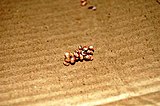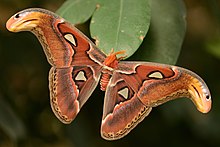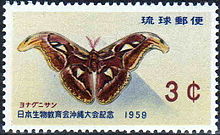Attacus atlas
| Atlas moth | |
|---|---|

| |
| Female with reduced antennae | |
| Scientific classification | |
| Domain: | Eukaryota |
| Kingdom: | Animalia |
| Phylum: | Arthropoda |
| Class: | Insecta |
| Order: | Lepidoptera |
| Family: | Saturniidae |
| Genus: | Attacus |
| Species: | A. atlas
|
| Binomial name | |
| Attacus atlas | |
Attacus atlas,theAtlas moth,is a largesaturniidmothendemic to the forests of Asia. Thespecieswas described byCarl Linnaeusin his 175810th edition ofSystema Naturae.
The Atlas moth is one of the largestlepidopterans,with a wingspan measuring up to 24 cm (9.4 in)[1]and a wing surface area of about 160 cm2(≈25 in2).[2]It is only surpassed in wingspan by thewhite witch(Thysania agrippina) andAttacus caesar,[1]and in wing surface area by theHercules moth(Coscinocera hercules). As in mostsilk moths,females are noticeably larger and heavier than males, while males have broaderantennae.[3][4][5]
Description
[edit]| Holometabolism(complete metamorphosis) | ||||
|---|---|---|---|---|

|

|

|

|

|
| Eggs | Larva(3rdinstar) | Pupawithincocoon | Emerging from pupa | Imago |
Eggs
[edit]Atlas moths lay a number of sphericaleggs,2.5 mm (0.098 in) in diameter, on the undersides of the leaves of food plants.
Larva
[edit]After approximately two weeks, dusty-greencaterpillarshatch and feed on their egg-shell, and then the foliage ofcitrus,cinnamon,guava,andevergreentrees.[6]The caterpillars can grow to 11.5 cm (4.5 in) in length and 2.5 cm (0.98 in) in thickness. They have white, waxy, fleshy spines along their backs, which become more prominent at laterinstars.On the last abdominal segment beside theprolegs,there is a large green spot surrounded by an orange ring.[7]
Pupa
[edit]After reaching a length of about 11.5 cm (4.5 in), the caterpillarspupate.They spin a 7–8 cm long paperycocooninterwoven with desiccated leaves and attach it to a twig using a strand of silk. The adult moths emerge from the cocoon after approximately four weeks depending on environmental factors.

Imago
[edit]
Adult Atlas moths are weak, unsteady fliers. To conserve energy, the moths rest during the day and fly at night. As they lack fully formedmouthparts,the adults cannot eat, subsisting entirely on fat reserves accumulated during the larval stage. As a result, they live for only a few days during which their sole objective is seeking out a mate. Adults may be found on wing throughout the year but are most abundant between November and January.
Females releasepheromonesthrough a gland on the end of theabdomento attract a mate. Females stay near discardedcocoons,seeking out a perch where the air currents will best carry their pheromones. Males can detect andhome inon these pheromones from several kilometers away usingchemoreceptorslocated on their featheryantennae.[8]
The body is small compared to the wings. The upper side of the wings is reddish brown with a pattern of black, white, pink, and purple lines. There are triangular, scale-less windows bordered in black on each of the four wings. The undersides of the wings are paler. The tips of both forewings have prominent extensions that resemble the head of a snake. The resemblance is exaggerated by movements of the wings when the moth is confronted by potential predators.[9]

The Atlas moth has a very short, vestigial proboscis, and they do not eat once they have emerged from the cocoon, relying on fat storage for energy. Every flight takes valuable energy and can take days off their already short lives, as it has a very short life span of only one to two weeks.[10]They conserve energy by flying as little as possible. A female will wait for a male to come along and be fertilised, lay eggs and die.
Habitat
[edit]
Theirhabitatis primarily drytropical forests,secondary forests,andshrublandsacrossSouth Asia,East Asia,andSoutheast Asia,includingBorneo.[11]
Etymology
[edit]Atlas moths are named afterAtlas,the Titan ofGreek mythology(due to their size). InHong Kong,theCantonesemeans "snake's head moth", referring to the prominent extension of the forewing that resembles the head of asnake.[12][citation needed]
Relationship with humans
[edit]
InIndia,Atlas moths are cultivated for theirsilkin a non-commercial capacity. Unlike silk produced by the relateddomestic silkmoth(Bombyx mori), Atlas moth silk is secreted as broken strands and is therefore less desirable. This brown, wool-like silk, known asfagara,is thought to have greater durability.[13]Atlas mothcocoonsare sometimes used as small pocket change purses inTaiwan.[citation needed]There is ongoing research as to whether the silk of the Atlas moth can be used as a substitute for common silks. The quality of the heavier cocoons, less restrictive rearing conditions, and competent properties of the fibers, make the silk produced by the Atlas moth a potential alternative for common silks. A study concluded that the silk fibers of the atlas moth had about an 80% higher density of cells and growth compared to the silk fibers of the silk moth.[14]
TheJapanesesubspeciesA. a. ryukyuensis,native toYonaguniin theYaeyama Islands.
Similar taxa
[edit]The term "Atlas moth" is sometimes used mistakenly as a name for any species in the genusAttacus,of which there are over 20 named species and subspecies.Attacus taprobanis[15]native tosouthern IndiaandSri Lanka[16]is very similar in morphology to the much more widely distributedAttacus atlas.It was once considered a subspecies ofA. atlas.[17]A fewNew Worldspecies can be mistaken for Atlas moths, specifically members of the genusRothschildia.Very similar in appearance to the Asian Atlas moth,Rothschildia aurotais one of the largest members of its genus and aNeotropicalrelative.
See also
[edit]References
[edit]- ^ab"Chapter 32: Largest Lepidopteran Wing Span | The University of Florida Book of Insect Records | Department of Entomology & Nematology | UF/IFAS".entnemdept.ifas.ufl.edu.
- ^"StackPath".australianbutterflies.com.26 October 2018.
- ^Watson, A. & Whalley, P.E.S. (1983).The Dictionary of Butterflies and Moths in Colour.Peerage Books, London, England.ISBN0-907408-62-1
- ^Robert G. Foottit & Peter H. Adler. 2009.Insect Biodiversity: Science and Society.Blackwell Publishing Ltd.ISBN978-1-405-15142-9
- ^Rainier Flindt. 2006.Amazing Numbers in Biology.Springer-Verlag, Berlin.ISBN3-540-30146-1
- ^Robinson, G.S., Ackery, P.R., Kitching, I.J., Beccaloni, G.W. & Hernández, L.M. (2001).Hostplants of the Moth and Butterfly Caterpillars of the Oriental Region.Southdene Sdn. Bhd., Kuala Lumpur & The Natural History Museum, London. 744 pp.ISBN983-40053-3-4
- ^Gosse, Philip Henry (1879)."The great Atlas moth of Asia (Attacus atlas,Linn.) ".West, Newman & Company– via Gale Primary Sources.
- ^Shepherd, G.M. (1994). "Chemical Senses". InNeurobiology3rd Edition. Oxford University Press
- ^Howse, P.E. (2010)Butterflies: Messages From PsychePapadakis, 192 pp.ISBN978-1901092806
- ^"Spotlight: the atlas moth".www.nhm.ac.uk.Retrieved2019-08-21.
- ^Holloway, J.D. (1987).The Moths of Borneo,part 3: Lasiocampidae, Eupteroptidae, Bombycidae, Brahmaeidae, Saturniidae, Sphingidae.Southdene Sdn. Bhd., Kuala Lumpur
- ^Yiu, V. (2006). Insecta Hongkongica. Hong Kong Discovery. Kowloon, Hong Kong. 655pp.ISBN988-97173-9-5
- ^Jolly, M.S., Sen, S.K., Sonwalkar, T.N. & Prasad, G.S. (1979). Non-mulberry silks. Food & Agriculture Organisation. United Nations, Serv. Bull. 29. Rome. xvii + 178pp
- ^Reddy, Narendra; Zhao, Yi; Yang, Yigi (2013)."Structure and Properties of Cocoons and Silk Fibers Produced by Attacus Atlas".Journal of Polymers and the Environment.21:16–23.doi:10.1007/s10924-012-0549-8.S2CID9466921– via Science Citation Index.
{{cite journal}}:CS1 maint: multiple names: authors list (link) - ^Moore, Frederic(1880).The Lepidoptera of Ceylon. Vol. II.London: L. Reeve & co. pp. 124–125.
- ^Peigler, Richard S. (1989).A Revision of the Indo-Australian GenusAttacus(Lepidoptera: Saturniidae).Lepidoptera Research Foundation.ISBN0961146427.Retrieved5 June2018.
- ^Savela, Markku."Attacus atlas(Linnaeus, 1758) ".Lepidoptera and Some Other Life Forms.RetrievedNovember 10,2018.
